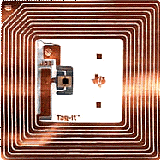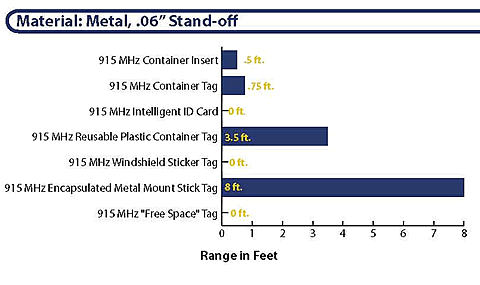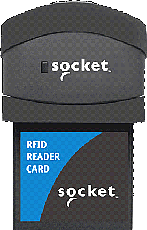Hardware Specifications
The hardware for the Computer Asset Management consists of Radio Frequency Identification (RFID) tags, and RFID Reader or Scanner, and a computer.
RFID Tags

Passive RFID Tags have no internal battery power. They use the RF energy from the reader to generate their response. Due to this dependency, a passive tag's maximum range is approximately six meters. Also, with the limited capacity only an identification number is stored. Without the need for a power source, passive tags can be manufactured at very small sizes and at a comparatively small price.
Active RFID Tags, on the other hand, has an internal battery, longer range, and the capacity to store more information. They are used in certain environments such as water or with large containers where their increased performance merits the increased cost. These additional capabilities add to the size and price of active tags. The advantage of either of these types over other technologies, such as bar coding, is an RFID system can be read without the need of close line of sight with the scanner. Figure 1 shows a few types of RFID tags and their typical uses.
There are four different types of RFID tags commonly in use. They are categorized by their radio frequency:
- Low frequency tags operate at 125 or 134.2 kHz
- High frequency tags operate at 13.56 MHz
- UHF tags operate at 868 to 956 MHz
- Microwave tags operate at 2.45 GHz.
Here is the example of RFID range for RFID tags placed on metal surface:

RFID tags are further divided into their ability to accept changes to the data encoded on them. Write Once-Read Many or WORM tags are commonly referred to as read-only tags and are "pre-printed" by the manufacturer. Once a read-only RFID tag is programmed, the data cannot be altered for the life of the tag. These tags are the least expensive of the RFID tags. Research has shown that these tags can be obtained for as little as $0.40 each.
The other RFID tag is a re-writable tag. These tags are blank when first purchased and can be programmed and re-programmed by the user. Use of these tags requires an RFID tag "printer" or writer and appropriate software.
RFID Reader

The RFID reader sends out a signal that will be returned by any tag in its
range. It decodes the tag's ID and presents that information to the software
Application Programming Interface (API). The reader or scanner device receives
the tag signal with its antenna, decodes it and transfers the data to the host
computer system. Interrogator capabilities have been engineered to now be able
to fit into small mobile devices. Mobile devices can read 105 mm tags from a
distance of 1.5 meters using a single antenna and process up to 6 tags per second.
Because direct line of sight between the reader and tags is not necessary, there
are many more placement options for RFID readers than were possible with bar
code labels.
Manufacturers have built RFID reader capabilities into PCMCIA and Compact Flash
cards. This provides the capability to turn almost any handheld computer into
an RFID reader. Data gathered
can then be transmitted to a host system by 802.11g or other wireless technology. The cost for RFID readers can range from more than $5000 for fixed readers to just over $300 for the PCMCIA and Compact Flash units.
